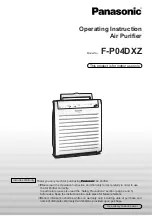
3
FIRE, EXPLOSION HAZARD
Failure to follow this warning could result in personal
injury, death and/or property damage.
Improper installation, adjustment, alteration, service, or
maintenance can cause property damage, personal
injury, or loss of life. Refer to the User’s Information
Manual provided with this unit for more details.
Do not store or use gasoline or other flammable vapors
and liquids in the vicinity of this or any other appliance.
What to do if you smell gas:
1. DO NOT try to light any appliance.
2. DO NOT touch any electrical switch, or use any
phone in your building.
3.IMMEDIATELY call your gas supplier from a
neighbor’s phone. Follow the gas supplier’s
instructions.
4. If you cannot reach your gas supplier, call the fire
department.
!
WARNING
GENERAL
This publication contains Start--Up, Controls, Operation, Service,
and Troubleshooting information for the 48/50PG and 48/50PM
rooftop units. (See Table 1.) These units are equipped with
Comfort
Link
t
controls version 4.X or higher and use Puron
r
refrigerant. The specific base unit installation instructions and/or
wiring label diagram may also be required in conjunction with this
book as a guide to a specific unit on the roof. All the units in table
1 are Constant Volume (CV) units that provide stand--alone or
network operation.
Table 1 – Rooftop Units
MODEL
SIZE
NOMINAL TONS
48/50PG
03
2
04
3
05
4
06
5
07
6
08
7.5
09
8.5
12
10
14
12.5
16
15
20
18
24
20
28
25
48/50PM
16
15
20
18
24
20
28
25
BASIC CONTROL USAGE
Comfort
Link Control
The
Comfort
Link control is a comprehensive unit-management
system. The control system is easy to access, configure, diagnose
and troubleshoot.
The
Comfort
Link control is fully communicating and cable-ready
for connection to the Carrier Comfort Network
®
(CCN) building
management
system.
The
control
provides
high-speed
communications for remote monitoring via the Internet. Multiple
units can be linked together (and to other
Comfort
Link control
equipped units) using a 3-wire communication bus.
The
Comfort
Link control system is easy to access through the use
of a unit-mounted display module. There is no need to bring a
separate computer to this unit for start-up. Access to control menus
is simplified by the ability to quickly select from 11 menus. A
scrolling readout provides detailed explanations of control
information. Only four, large, easy-to-use buttons are required to
maneuver through the entire controls menu. The display readout is
designed to be visible even in bright sunlight.
For added service flexibility, an accessory hand-held Navigator
™
module is also available. This portable device has an extended
communication cable that can be plugged into the unit’s
communication network at the main control box. The Navigator
display provides the same menu structure, control access and
display data as is available at the unit-mounted Scrolling Marquee
display.
Run Status
Service Test
Temperature
Pressures
Setpoints
Inputs
Outputs
Configuration
Time Clock
Operating Modes
Alarms
Alarm Status
ENTER
MODE
ESCAPE
C06320
Fig. 1 -- Scrolling Marquee
Scrolling Marquee
This device is the keypad interface used to access the control
information, read sensor values, and test the unit. The Scrolling
Marquee is located in the main control box and is standard on all
units. The Scrolling Marquee display is a 4-key, 4-character,
16-segment LED (light-emitting diode) display module. The
display also contains an Alarm Status LED. (See Fig. 1.)
The display is easy to operate using 4 buttons and a group of 11
LEDs that indicate the following menu structures:
S
Run Status
S
Service Test
S
Temperatures
S
Pressures
S
Set points
S
Inputs
S
Outputs
S
Configuration
S
Timeclock
S
Operating Modes
S
Alarms
Through the Scrolling Marquee, the user can access all of the
inputs and outputs to check on their values and status, configure
operating parameters plus evaluate the current decision status for
operating modes. The control also includes an alarm history which
can be accessed from the display. In addition, through the Scrolling
Marquee, the user can access a built-in test routine that can be used
at start-up commissioning and to diagnose operational problems
with the unit. (See Table 2.)
48/
50P
G
and
P
M
Содержание 48/50PG Series
Страница 32: ...32 C07009 Fig 20 Air Baffle Dimensions 48 50PG03 16 48 50PG and PM...
Страница 33: ...33 C08077 Fig 21 Air Baffle Dimensions 48 50PG20 28 and 48 50PM16 28 48 50PG and PM...
Страница 58: ...58 C08549 Fig 28 48PG03 16 Control Wiring Schematic 48 50PG and PM...
Страница 59: ...59 C08550 Fig 29 50PG03 16 Control Wiring Schematic 48 50PG and PM...
Страница 60: ...60 C08551 Fig 30 Typical 48 50PG03 16 Power Wiring Schematic and Legend 48 50PG16 460 3 60 Shown 48 50PG and PM...
Страница 64: ...64 C08471 Fig 34 Typical 48PG and PM16 28 Control Schematic 48PM16 28 Shown 48 50PG and PM...
Страница 66: ...66 C08557 Fig 36 Typical 50PG and PM16 28 Control Schematic 50PG20 28 Shown 48 50PG and PM...
Страница 67: ...67 C08064 Fig 37 Typical 50PG and PM16 28 with Humidi MiZert Control Schematic 50PM16 28 Shown 48 50PG and PM...
Страница 68: ...68 C08558 Fig 38 Typical 48 50PG and PM16 28 Power Schematic 48 50PM16 28 Shown 48 50PG and PM...
Страница 72: ...72 C08565 Fig 42 Typical 48 50PG20 28 Component Arrangement 48 50PG20 24 Shown 48 50PG and PM...
Страница 73: ...73 C08067 Fig 43 48 50PM16 28 Component Arrangement 48 50PG and PM...
Страница 74: ...74 C08562 Fig 44 48 50PM16 28 with Humidi MiZert Component Arrangement 48 50PG and PM...
Страница 208: ...208 48 50PG and PM...




































